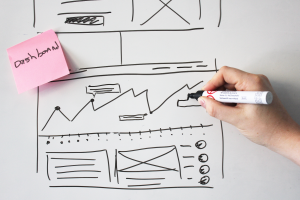1. Consider the people around us as potential users
A first effective approach to UX thinking is to study your surroundings. Although the job of UX Designer is above all to focus 100% on the user, we quite often forget to observe the people we meet daily, our colleagues, our friends.
One of the things we learn as UX-Designers is to get to know our users. We go out and study them. But who are our users? They are our bosses, the bosses of the bosses. Why not study them? What is important to them? – Don Norman
We generally learn as UX, to be vigilant and to observe the people we work with when we are on a new mission or when we integrate new teams. Understanding one's surroundings gives us critical information to use in developing a strategic business response. As specialists, we must constantly take into account the expectations and needs of users in order to offer a product that suits them. The UX Designer learns to put himself in the shoes of the users to ensure that the process he puts in place, the strategies he develops and the effect he gives to a product will speak to the user and will respond well to the expectations he hopes for.
2. Estudying is not enough as, you have to have empathy
as, you have to have empathy
Intimately linked to his environment, the UX Designer must have empathy. He must understand the daily life of a user, feel the pressure he may be under and his concerns. The ultimate goal is to transform these feelings into strategic responses to achieve mutual success.
Working together with the client instead of trying to convert him to our own ideas leads him to think about a more user-oriented vision. He ends up having a taste of what the product can bring to the user by putting himself in his place. During the workshops, the UX Designer must remain attentive to his interlocutors, understand them and help them to a certain extent. This allows him to create a climate of trust with the client and facilitate his exchanges.
Showing empathy towards your team members can help the project's effectiveness. Having the last word doesn't matter much if it comes at the cost of losing it. The user has no vision on what happened during the design of the product, he will simply notice that the product does not correspond to his expectations and lose interest in it. It is the role of the UX to work with their team so that progress is constantly made.
In addition, having an interest in a person other than ourselves allows us to find ourselves in an area of agreement with our interlocutor: We are more open to discussion, the person will then be more eager to listen to what we have has to offer him and will be inclined to support our ideas.
3. Establish a relationship
It is not enough to study your surroundings and have a little empathy to launch headlong into production. Above all, you must use this understanding to create a climate of trust and a lasting relationship with the members of your team in order to then move forward together. As an expert, the UX is aware that it is the long-term relationship that the user has with his product or service that is the indicator of the successful completion of the project. The user perceives the product as a whole and does not stop at one feature. This is exactly how the UX Designer should view their team.
4. Don't forget that UX design doesn't speak to everyone
 We must be aware of the fact that the people we work with may not be comfortable with the concept and our profession of UX Designer. You have to take the time to explain it to them.
We must be aware of the fact that the people we work with may not be comfortable with the concept and our profession of UX Designer. You have to take the time to explain it to them.
Once some clear explanations have been made about our profession, with simple vocabulary that speaks to everyone, we can discuss the issues and the importance of UX in a project, both from the point of view of the designing company and the final user.
In particular, we can show them examples of good UX practices, and ask them about their personal vision of a successful UX, what they think of the current UX project...
This creates a solid foundation to get them to accept our point of view and understand the contribution that UX expertise can have on the final product.
So the next time you feel frustration rising, take a deep breath and remind yourself to put yourself in the other person's shoes.
- You are able to ask questions to better understand the point of view of your interlocutor rather than trying to convince him that your vision is the best.
- You are able analyze a situation and adopt the vision of your interlocutor.
- You keep in mind that the conversation you have with your interlocutor will be a conversation among others and that you will have to make this person want to start other conversations with you in the future.
- You can take a moment to Discuss a topic related to UX who can help him better understand what you are doing.
If each of these criteria are met then you are well on your way to a successful UX design.
Translation of the article 4 techniques for a successful UX.
Thierry Andrianalisoa – UX-Activist @UX-Republic
STORYTELLING: THE ART OF CONVINCING # Paris
SMILE Paris
163 quay of Doctor Dervaux 92600 Asnières-sur-Seine
UX/UI ECO-DESIGN # Paris
SMILE Paris
163 quay of Doctor Dervaux 92600 Asnières-sur-Seine
DESIGN THINKING: CREATING INNOVATION # Belgium
UX-REPUBLIC Belgium
12 avenue de Broqueville - 1150 Woluwe-Saint-Pierre
MANAGING AND MEASURING UX # Paris
SMILE Paris
163 quay of Doctor Dervaux 92600 Asnières-sur-Seine
DESIGN SPRINT: INITIATION & FACILITATION # Paris
SMILE Paris
163 quay of Doctor Dervaux 92600 Asnières-sur-Seine
UX-DESIGN: THE FUNDAMENTALS # Belgium
UX-REPUBLIC Belgium
12 avenue de Broqueville - 1150 Woluwe-Saint-Pierre
GOOGLE ANALYTICS 4 #Paris
SMILE Paris
163 quay of Doctor Dervaux 92600 Asnières-sur-Seine
ACCESSIBLE UX/UI DESIGN # Belgium
UX-REPUBLIC Belgium
12 avenue de Broqueville - 1150 Woluwe-Saint-Pierre













